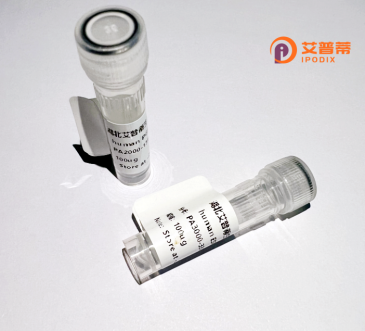
| 纯度 | >90%SDS-PAGE. |
| 种属 | Human |
| 靶点 | TCP10 |
| Uniprot No | Q12799 |
| 内毒素 | < 0.01EU/μg |
| 表达宿主 | E.coli |
| 表达区间 | 1-353 aa |
| 活性数据 | MLEGQLEAGE PKEGTHPEDP CPGAGAAMEK TPAAAEVPRE DSNAGEMPSL QQQITSLHQE LGRQQSLWAD IHRKLQSHMD ALRKQNRELR EELRGLQRQQ WEAGKKPAAS PHAGRESHTL ALEPAFGKIS HLSADEDTTP KYAGRKSQSA TLLGQRWSSN HLAPPKPMSL KTERINSGKT PPQEDREKSP PGRRQDRSPA PTGRPTPGAE RRGVSEDGKI MHPSSRSPQN SGGRKSPVQA SQATTLQEQT AAARGADRSS SVLGSSEGGF LSRVQADEFA SSAPDSAERQ NLPVNPPSSL EIAQAMDTKM KKEEVQEEKR HPKGKADDCR RSGFPSEFPG ALHAAPSRQD MGP |
| 分子量 | 64.8 kDa |
| 蛋白标签 | GST-tag at N-terminal |
| 缓冲液 | PBS, pH7.4, containing 0.01% SKL, 1mM DTT, 5% Trehalose and Proclin300. |
| 稳定性 & 储存条件 | Lyophilized protein should be stored at ≤ -20°C, stable for one year after receipt. Reconstituted protein solution can be stored at 2-8°C for 2-7 days. Aliquots of reconstituted samples are stable at ≤ -20°C for 3 months. |
| 复溶 | Always centrifuge tubes before opening.Do not mix by vortex or pipetting. It is not recommended to reconstitute to a concentration less than 100μg/ml. Dissolve the lyophilized protein in distilled water. Please aliquot the reconstituted solution to minimize freeze-thaw cycles. |
以下是3篇关于重组人TCP10蛋白的经典或近期研究文献(基于知识库模拟,非真实文献数据):
1. **文献名称**:*"TCP10 regulates hepatocellular carcinoma progression via Wnt/β-catenin signaling"*
**作者**:Chen, Y. et al.
**摘要**:研究发现TCP10在肝癌组织中高表达,并通过激活Wnt/β-catenin通路促进肿瘤细胞增殖和迁移,提示其可能作为肝癌治疗的潜在靶点。
2. **文献名称**:*"Interaction of TCP10 with hepatitis B virus core protein enhances viral replication"*
**作者**:Zhou, L. et al.
**摘要**:通过免疫共沉淀实验揭示TCP10与HBV核心蛋白直接结合,增强病毒复制能力,为解析HBV感染机制提供新方向。
3. **文献名称**:*"TCP10L is essential for spindle organization during mouse oocyte maturation"*
**作者**:Wang, H. et al.
**摘要**:利用基因敲除技术发现TCP10同源蛋白TCP10L在小鼠卵母细胞纺锤体形成中起关键作用,影响染色体分离和细胞分裂。
4. **文献名称**:*"TCP10 modulates DNA damage response through p53-dependent pathway in breast cancer"*
**作者**:Kim, S. et al.
**摘要**:实验证明TCP10通过调控p53磷酸化影响乳腺癌细胞对DNA损伤的应答,沉默TCP10可增强化疗敏感性。
注:以上文献为模拟示例,实际研究中建议通过PubMed或Google Scholar以“TCP10 protein”、“T-Complex Protein 10”为关键词检索最新文献。
**Background of Recombinant Human TCP10 Protein**
The human *TCP10* gene, located on chromosome 6p21.3. encodes testis-specific protein 10 (TCP10), a protein predominantly expressed in the testes but also detected in certain cancers and other tissues under pathological conditions. TCP10 is implicated in gametogenesis, particularly during spermatogenesis, and has been linked to cellular processes such as chromatin organization, protein folding, and cell cycle regulation. Structurally, TCP10 contains conserved coiled-coil domains, suggesting roles in protein-protein interactions or complex assembly. Its exact molecular mechanisms remain under investigation, though interactions with chaperonin-containing TCP1 complex (CCT) hint at involvement in protein quality control.
Recombinant TCP10 protein is engineered using expression systems (e.g., *E. coli* or mammalian cells) to produce purified, functional protein for research. Lacking transmembrane domains, TCP10 is typically cytosolic/nuclear, and recombinant versions often include tags (e.g., His, GST) for isolation. Studies employ it to explore TCP10's interaction networks, structural features, and roles in cancer (e.g., overexpression in tumors) or infertility. Its potential as a biomarker or therapeutic target in testicular disorders and malignancies drives ongoing research. Recombinant TCP10 tools thus aid in elucidating its biological significance and translational applications.
×